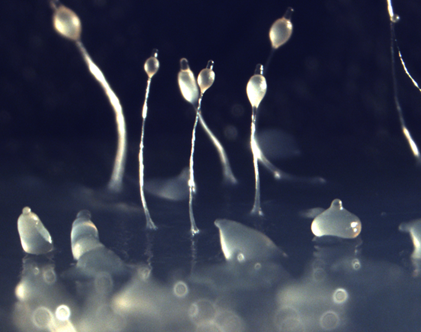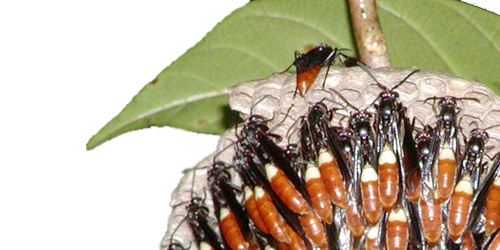An interesting article appeared in the NY Times a couple of days ago. I have my doubts about the general appeal of a rap performance about evolutionary biology, but maybe it’s great. Who knows? You can investigate Baba Brinkman’s “The Rap Guide to Evolution” for yourself here and here.
Of particular interest, the article highlights one part of the show:
Dictyostelium is notorious, in some circles, for its strange life-style. Usually, an individual Dictyostelium lives alone as a single cell. But when food is scarce, the single cells come together and form a being known as “the slug”; this crawls off in search of better conditions. When it finds them, the slug develops into a stalked fruiting body, and releases spores. But here’s the mystery: not all members of the slug get to make spores — and thereby contribute to the next generation — so why do they cooperate?
Dictyostelium is an incredibly interesting group of organisms. A genus of usually solitary, single-celled amoebae, members of the group are also facultatively social. Individual Dictyostelium cells spend most of their life on the forest floor, eating bacteria. When bacteria become scarce, and the amoeba cells start to starve, they release chemical pulses that draw individual cells together. Once together, the cells form a mound of cells, all piled on top of each other. And then something amazing happens, the mound starts to crawl (yes, crawl) as one unit, across the forest floor. This slug is now, by any reasonable definition, a multicellular individual.

A beautiful image of a Dictyostelium discoideum slugs (bottom) and stalks with spore masses on top. Photo credit: Owen Gilbert
But that’s not the end of this startling story. After crawling away a bit (and by the bye, these slugs are visible and you can watch them crawl), cells at the leading edge organize themselves into a stalk, a pillar, via which the lagging cells in the slug will eventually ascend. The stalk cells die, and the other cells crawl up the stalk and become a mass of sporulating cells, leaving clonal offspring that might disperse from the impoverished environment more easily because of the (slight) height. (Well, in fact, this particular sequence is not universal. Some species of Dictyostelium do it differently, but the ultimate product, the formation of a slug and stalked spore body, is the same).
The comparison to wasp workers and queens is clear enough, but the comparison to our bodies is even clearer. Dictyostelium is a group with sterile worker cells and reproductive cells, and the group is composed of genetically identical cells ( . . . well, sometimes). We are a group of cells with sterile workers cells (our soma, all of our tissues and body parts) and reproductive cells (our germ, egg and sperm). The only difference (and it’s a big one, admittedly) is that our worker cell caste has differentiated into many subcastes—different sterile cell types and tissues composed of sterile cells—just like the workers of highly social wasps.
So Dictyostelium is sort of like Polistes: it has cycles of solitary and social, and it bridges the gap between completely selfish and altruist. (In fact, some of the most important work on Dictyostelium comes from the lab of two former(-ish) social wasp researchers). Given this, the next time someone tells you there are no transitionary intermediates that reveal major shifts in evolution, you can point them to Dictyostelium.
So the question: Why do Dictyostelium cells seemingly willingly, suicidally sacrifice themselves, forgo reproduction, and form the structure (the tissue) that is the stalk? The same question applies to worker wasps, and the cells in your finger. The beginings of the answer were provided by Darwin, but the mathematical framework wasn’t worked out for just over a century later, by über-famous social wasp researcher Bill Hamilton. Hamilton’s insight was as simple as it was brilliant.
It goes like this. Imagine an individual I will call the actor. The actor has two reproductive choices: She can reproduce directly by having her own offspring (thus leaving her genes and heritable tendencies, including her tendency to reproduce directly), or she can reproduce indirectly by assisting relatives have enough additional offspring such that they compensate for our actor’s sacrifice in direct reproduction. This works because relatives share genes. So, for example, our actor (let’s assume she’s a human now) could have one child, or help a sister have two additional children (over the children her sister would normally have absent our actor’s help). Because our actor and her sister share genes by descent, in each case, the same amount of genes are left by the our actor. If the actor has one child, she leaves half of her genes to the next generation. If the actor helps her sister have two additional offspring—because she’s related to her full sister by half, and thus related to her nieces and nephews by one quarter—then our actor leaves two times one quarter of her genes, or half, the same as if our actor had one child directly.
Some individuals in populations will have heritable tendencies for direct reproduction (the selfish tendency). Others (due to natural variation) will have heritable tendencies for indirect reproduction (essentially, helping, or being a worker, an altruist). Whichever individuals actually reproduce more, leaving more copies of their genes—including their heritable tendencies for either selfish direct reproduction or altruist indirect reproduction . . . whichever tendency happens to leave the most genes to the next generation will become more common, generation after generation. The other tendency will wane. Either tendency could be more successful, and this can change depending on other external, environmental factors. But whatever the context, if being a sterile helper results in more genes’ being shuttled into the next generation, that tendency will evolve. And the same goes for the tendency for direct reproduction. Neither tendency is universally better. Natural selection decides.
In Dictyostelium, this calculus is simplified, because the cells are (often) all clones of one another, so if one cell reproduces directly or by helping a clone reproduce, the reproductive success to each cell is the same. In this context, conflict-free cooperation can much more easily evolve. Of course, I’ve already pointed out in previous blogs that mutation can strike, and change the behavior of a cell, just like in our bodies. When this happens, the happy harmony is disrupted, and the cheater cell might corrupt the system by reproducing wildly, or otherwise refusing to engage the social contract. This happens in Dictyostelium, just as it does in us. All social systems have cheaters, cancer.
The harmony of Dictyostelium can also be disrupted when slugs are composed of genetically different cells, or even (sometimes) different species. When this happens, cells don’t easily sacrifice themselves and become stalk tissue. It’s easy to see why that behavior might not be favored by natural selection. In this context, becoming a sterile worker might mean very little or no indirect reproduction (for example, if the spores are all distant relatives of the stalk cell). If sterility and helping leave no genes indirectly, the behavior washes away over generations. The only tendencies that are left are the selfish: In a mixed group, fight for direct reproduction or perish. So, this generates great conflict, and individual cells in the slug try to position themselves such that they will be in the spore mass.
Because of this kind of conflict, it was long ago predicted that members of social groups should be able to recognize close relatives. Since that prediction—a prediction that derives directly from the mathematical evolutionary framework I describe above—many social creatures have been shown to recognize kin. You might think this kind of conflict (from genetically distinct cells) has little bearing on humans, but it’s exactly the kind of conflict that stem cell transplants can generate. The potential for that conflict is playing itself out in me now. My new cells have kin recognition abilities, and if they aren’t tricked into thinking my body is kin, a significant conflict may erupt.
So now, I’m like a mixed colony of Dictyostelium. Having hopefully exterminated the mutant cheater cancer cells, I now face yet another other social conflict. As time passes, the probability of that conflict rises.
























